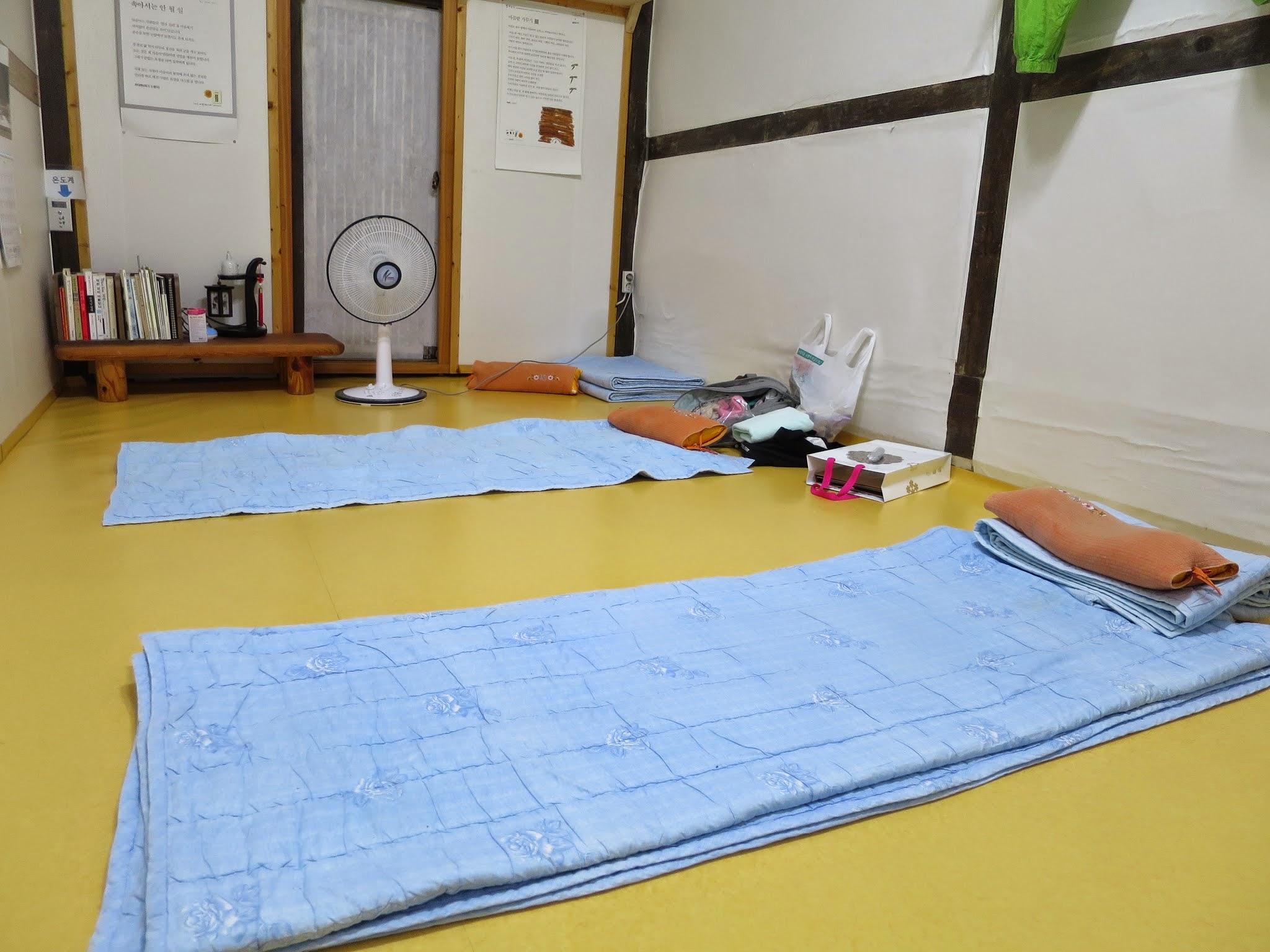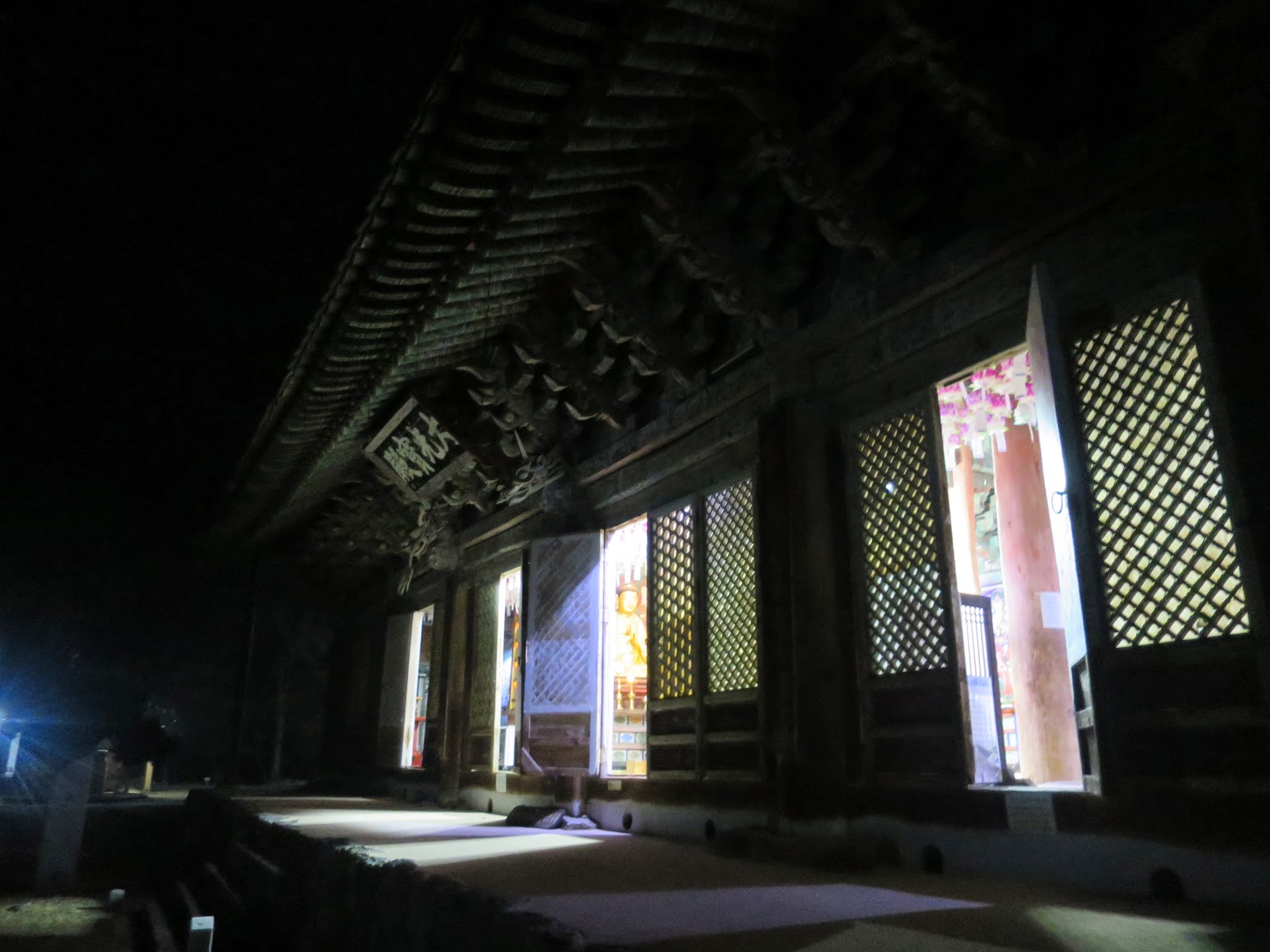It’s a dream I revisit often, more these recent months. I am with strangers in a white minivan, winding its way through the rice-paddy green of a back road in South Korea. The road begins to ascend, and then we are in a low, undulating deciduous forest of birch and alder. We arrive somewhere and get out. A stone bridge blanketed in white paper lanterns leads over a small river, past an open-air wooden gate where giant, muscular guardian gods painted in red and green and turquoise suggest what lies within is special.
A campus of wooden buildings sits on manicured dirt courtyards. Tiled roofs, gently upturned; stone stairs leading to porticos where doors slide open, their latticework frames perfect and delicate. The group of strangers are paired off, and I am directed to a small room along with one other – a woman from Seoul.

Outside the door, we take our shoes off and slide on plastic shower slippers. The room is plain and small: a fan, a bookshelf of Buddhist texts, two floor mats and pillows for sleeping. We are given matching, plain blue uniforms: simple cotton trousers and shirt.
****
We gather later in the dining room – a big echoing hall with a buffet and long, vinyl banquette tables reminiscent of a summer camp canteen. Across the corridor, shared shower rooms, each cubicle with windows opening out into the leafy beyond.

I worry unnecessarily about my appetite. But we aren’t supposed to go hungry here. Eat as much as you like, a monk smiles, just make sure nothing is wasted. I take a plastic bowl and metal chopsticks from the pile at the end of the buffet, then scoop some rice, greens, wild mushrooms, courgette and tofu in, topped with kimchi. The bowl isn’t full. I eat everything, and wash it down with fresh water, then go again. Half a bowl, just enough, eat it all. Am I full? Maybe a little more. Every grain of rice gone? Yes. Okay, clean your bowl over there now.
After dinner, we pad sockfooted into a gathering hall where meditation pillows are arranged in a semi-circle, each fronted by a bamboo tray with green tea service and cakes. We sit, we wait. A monk enters swiftly; his head is shaved and the long, wide sleeves of his robes waft on some unfelt breeze.

The monk sits, and speaks of cleansing the mind, of non-attachment, of letting go of desire. He asks if there are questions. The strangers are silent, and I am silent. A mosquito buzzes in my ear, the overhead lightbulbs are bare and seem harsh and bright for such soul-scratching conversation. Then, says the monk, we shall have cake.
****
Night falls. We feel our way past the soft curving walls of silent buildings, over settled dusty walkways, back to our rooms. The stream, somewhere out of sight, reminds us the world ticks on. The bulb in the bedroom is as bright as the one we sat under in the hall with the monk, and a few moths find their way past the screen door before it slides shut. I switch on the fan and lay on my bedroll, watching the moths circling wildly under the bulb. There is no internet, no connectivity, nothing but the dull ache of thoughts.

9pm. A huge, antique bell is sounded somewhere outside. We rise, slip our shoes back on and crackle across the stone courtyard to the main temple hall. Shoes are left recklessly in pairs all over the steps.

Inside, cushions are set in perfect rows on huge carpets; the walls lined with scrolls and silks worn by the energy of seekers and dripping with prayer. It is warm and smells of incense and socked feet and late evening dew. Outside a brain-rattling symphony of crickets. We sit cross-legged. A small, well-used paper booklet offers the chants in Korean script, with approximated pronunciations below in Roman letters. We start chanting and it feels awkward and stilted, until it doesn’t and then it begins to feel dizzying and I wonder if I am hypnotised. Some regulars at the temple are sitting in front of me and they know the ropes. They anticipate the monk’s words and they know when to bow. I follow. It’s physically exhausting.
Stand. Hands together at the heart. Lower into a kneel, lower forehead to the floor, palms to the floor, then palms lift, hands return to heart, head up, stand. Repeat. Again. Again. 108 agains.
****
Hours before dawn, the gong sounds once more and we get up, gathering half awake in hushed tones, shivering under our cotton uniforms in the main courtyard. The pale violet hint of a new day casts imperceptible shadows. A nun tells us not to speak, and leads us single-file into the forest. Clear your mind, she says, follow me.

We walk. I do not know for how long. I can’t see, swimming in darkness but flooded by sound. The river gets closer, we get closer to it. It is close now, it is very loud. The splash of water over rocks like fireworks in my ears. My breath a soundtrack, each exhale puffing in a small, deafening white cloud. A gentle crunch underfoot loud as a thunderclap. Squirrels awakened early, rustling branches in such bright noise it could signal the end of the world. And it is also emphatically quiet. It is silent. Everything is still and moving. I am alive. I am. I am.

Dawn breaks as we sit down on dewy grass, our bums instantly wet and cold and stained. Now, it is social time! the nun smiles. Please, talk warmly together! It is strange, so suddenly, to return into my body. To engage with another being. What should we say. We are alive. We are together. How can we even capture this feeling in words? Do you have children? What brings you here? Look how the sun creeps up over that peak.

The grey mist of proper morning is cast over everything when we return to the temple. A monk shows us to an open-air porch enclosed by screens, below which runs another small creek trickling over stones. He indicates to sit, legs outstretched, on huge pillows. The pillows are warm and the air is so cool and wet and the stream sings its pebble song.
I close my eyes. This is not a dream.
I am alive. I am.
****
This story takes place at Bulguksa, an 8th century Buddhist temple on the slopes of Mt Toham in Gyeongsang-do, South Korea. Bulguksa is the head of the Jogye Buddhist order. It is a temple of exceptional significance in Korea and is a Unesco World Heritage Site. My stay was arranged through the incredible Templestay program, something I would encourage all seekers of themselves to do, if they are able.

I write for free. If you enjoy my writing and have the means, you may toss some coins into my tip jar or buy me a coffee on Ko-fi.

Leave a comment